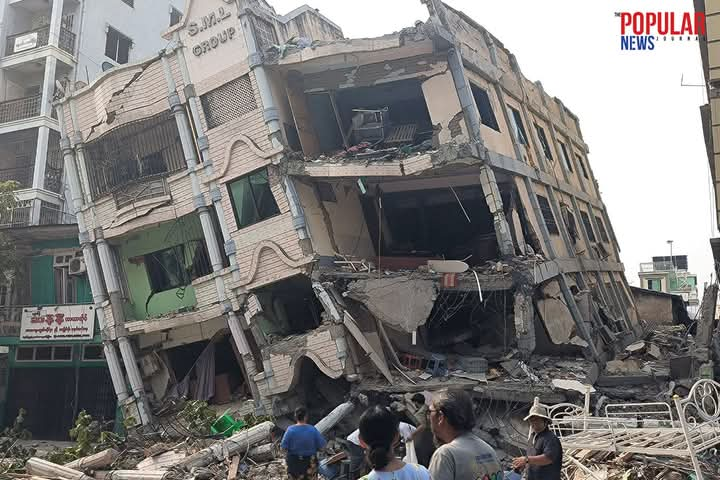“Who’s Responsible for Myanmar’s Earthquake Deaths? The Junta’s Role in a Preventable Tragedy”
On March 28, 2025, a catastrophic 7.7-magnitude earthquake struck Myanmar, flattening villages, crushing infrastructure, and claiming over 5,400 lives. But while the tremor itself was inevitable—Myanmar sits on one of the world’s most active fault lines—the staggering death toll was not.
Natural disasters test governments. They reveal who prioritizes people over power, preparedness over propaganda, and compassion over control. In Myanmar’s case, the military junta, led by Min Aung Hlaing, failed on all fronts. What unfolded was not just a tragedy of geology, but a man-made catastrophe—a direct consequence of the junta’s systemic neglect, corruption, and brutality.
This is how the Tatmadaw turned an earthquake into a genocide-by-neglect.
1. Neglected Infrastructure: A Disaster Waiting to Happen
Myanmar’s Sagaing Fault has produced deadly quakes for centuries. Yet under junta rule, disaster preparedness was never a priority.
- Defunded Resilience: Since the 2021 coup, the military diverted 70% of the national budget to its war machine, slashing funding for infrastructure maintenance and seismic retrofitting. Schools, hospitals, and bridges crumbled long before the quake.
- Corruption Over Concrete: Junta-linked cronies siphoned funds meant for public projects. In Mandalay, a 2023 audit found that $12 million earmarked for earthquake-resistant housing vanished into generals’ pockets.
- No Early Warning Systems: Neighboring Thailand and China have nationwide earthquake alerts. Myanmar’s junta dismantled existing systems, leaving millions unaware of the looming tremor.
The Result: Collapsing buildings accounted for 82% of deaths, many in poorly constructed homes and junta-built low-income housing.
2. Blocked Aid: Weaponizing Suffering
When the earthquake struck, the world rushed to help. The junta rushed to obstruct.
- Checkpoints of Death: Military roadblocks barred aid convoys from reaching hardest-hit regions like Sagaing and Karenni, where anti-junta resistance is strong. Volunteers reported soldiers confiscating food, medicine, and tents for military use.
- Bureaucratic Blackmail: The junta demanded NGOs partner with its proxy organizations (e.g., Union Solidarity and Development Party) to access disaster zones, delaying critical aid by weeks.
- International Aid as Propaganda: State media showcased junta leaders posing with foreign relief supplies—most of which were later sold on black markets.
A Mandalay medic, speaking anonymously, said: “People didn’t die from the quake. They died from infected wounds, dehydration, and the military’s bullets.”
3. Disaster as a Weapon: Targeting the Vulnerable
For the junta, the earthquake was an opportunity to punish dissent.
- Airstrikes on Survivors: In April 2025, the military bombed a makeshift camp in Magway Region, killing 47 displaced quake survivors. State media called them “terrorist sympathizers.”
- Forced Labor: In Yangon, soldiers conscripted survivors to clear rubble without pay, citing “national service.” Those who refused were shot.
- Ethnic Cleansing Under Rubble: Rohingya camps in Rakhine State received zero aid despite severe damage. Junta soldiers barred rescue teams, calling it a “warning to foreign meddlers.”
4. Silencing Dissent: Arresting the Rescuers
While the junta stalled, ordinary citizens mobilized. Their reward? Persecution.
- Criminalizing Compassion: Over 300 volunteers from Civil Disobedience Movement (CDM) groups were arrested for “illegal aid activities.” Many remain missing.
- Media Blackout: Junta censors banned the words “earthquake,” “death toll,” and “aid” from local media. Satellite internet terminals, critical for coordinating rescues, were declared “terrorist tools.”
- Exploiting Grief: State TV aired scripted interviews of survivors “thanking the Tatmadaw,” while hiding families who blamed the regime.
5. A Preventable Tragedy
Earthquakes don’t discriminate—but dictatorships do. Compare Myanmar’s response to Japan’s 2024 Ishikawa quake (similar magnitude, 241 deaths):
| Factor | Japan | Myanmar (Junta) |
|---|---|---|
| Early Warning Systems | Nationwide alerts 30 seconds prior | None |
| Building Codes | Strict enforcement since 1981 | Ignored; bribes bypass standards |
| Emergency Response | 100,000 trained responders | Aid blocked; volunteers arrested |
| Transparency | Real-time data shared globally | Media blackouts, fake reports |
The difference isn’t wealth—it’s governance.
The Junta’s Crime Against Humanity
Myanmar’s earthquake didn’t have to be this deadly. The junta’s decades of looting public funds, dismantling institutions, and waging war on its people created a nation uniquely vulnerable to disaster. When the ground shook, the military didn’t fail to act—it chose not to.
This is more than negligence. Under international law, deliberately denying lifesaving aid constitutes a crime against humanity. Until Min Aung Hlaing and his generals face justice, Myanmar’s people will remain trapped between the earth’s fury and the junta’s cruelty.
Call to Action
- Donate: Support bypass-the-junta aid groups like Free Burma Rangers or Progressive Voice Myanmar.
- Advocate: Pressure governments to recognize the junta’s disaster response as a human rights violation.
- Amplify: Share stories of Myanmar’s survivors—not the junta’s lies.
The earth shook, but the junta chose to let Myanmar fall.

